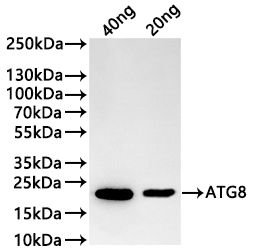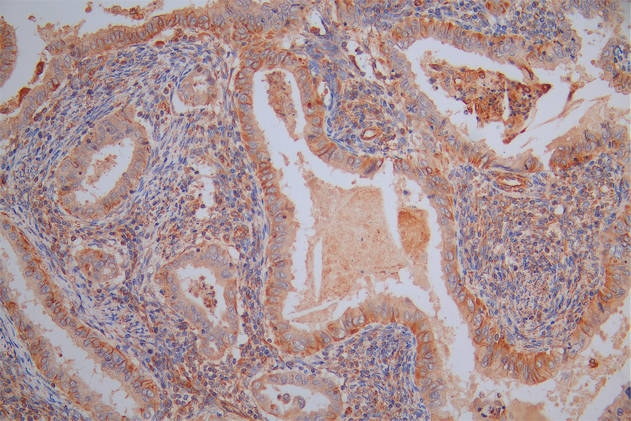ATG8 Antibody
-
中文名稱:ATG8 Antibody
-
貨號:CSB-PA327793XA01SVG
-
規格:¥880
-
圖片:
-
其他:
產品詳情
-
產品名稱:Rabbit anti-Saccharomyces cerevisiae (strain ATCC 204508 / S288c) (Baker's yeast) ATG8 Polyclonal antibody
-
Uniprot No.:
-
基因名:ATG8
-
別名:Autophagy-related protein 8 (Autophagy-related ubiquitin-like modifier ATG8) (Cytoplasm to vacuole targeting protein 5) ATG8 APG8 AUT7 CVT5 YBL078C YBL0732
-
宿主:Rabbit
-
反應種屬:Saccharomyces cerevisiae (strain ATCC 204508 / S288c) (Baker's yeast)
-
免疫原:Recombinant Saccharomyces cerevisiae (strain ATCC 204508 / S288c) (Baker's yeast) ATG8 protein (1-116aa)
-
免疫原種屬:Saccharomyces cerevisiae (strain ATCC 204508 / S288c) (Baker's yeast)
-
標記方式:Non-conjugated
-
克隆類型:Polyclonal
-
抗體亞型:IgG
-
純化方式:>95%, Protein G purified
-
濃度:It differs from different batches. Please contact us to confirm it.
-
保存緩沖液:Preservative: 0.03% Proclin 300
Constituents: 50% Glycerol, 0.01M PBS, pH 7.4 -
產品提供形式:Liquid
-
應用范圍:ELISA, WB
-
推薦稀釋比:
Application Recommended Dilution WB 1:500-1:5000 -
Protocols:
-
儲存條件:Upon receipt, store at -20°C or -80°C. Avoid repeated freeze.
-
貨期:Basically, we can dispatch the products out in 1-3 working days after receiving your orders. Delivery time maybe differs from different purchasing way or location, please kindly consult your local distributors for specific delivery time.
-
用途:For Research Use Only. Not for use in diagnostic or therapeutic procedures.
相關產品
靶點詳情
-
功能:Ubiquitin-like modifier involved in cytoplasm to vacuole transport (Cvt) vesicles and autophagosomes formation. With ATG4, mediates the delivery of the vesicles and autophagosomes to the vacuole via the microtubule cytoskeleton. Required for selective autophagic degradation of the nucleus (nucleophagy) as well as for mitophagy which contributes to regulate mitochondrial quantity and quality by eliminating the mitochondria to a basal level to fulfill cellular energy requirements and preventing excess ROS production. Participates also in membrane fusion events that take place in the early secretory pathway. Also involved in endoplasmic reticulum-specific autophagic process and is essential for the survival of cells subjected to severe ER stress. The ATG8-PE conjugate mediates tethering between adjacent membranes and stimulates membrane hemifusion, leading to expansion of the autophagosomal membrane during autophagy. Moreover not only conjugation, but also subsequent ATG8-PE deconjugation is an important step required to facilitate multiple events during macroautophagy, and especially for efficient autophagosome biogenesis, the assembly of ATG9-containing tubulovesicular clusters into phagophores/autophagosomes, and for the disassembly of PAS-associated ATG components. Plays also a role in regulation of filamentous growth.
-
基因功能參考文獻:
- ATG4B contains a C-terminal LIR motif important for binding and efficient cleavage of mammalian orthologs of yeast Atg8 PMID: 28287329
- findings show Atg4 is recruited onto autophagosomal membranes by direct binding to Atg8 via two evolutionarily conserved Atg8 recognition sites; propose a model where Atg4 activity on autophagosomal membranes depends on cooperative action of at least 2 sites within Atg4, in which one functions as a constitutive Atg8 binding module, while the other has a preference toward phosphatidylethanolamine-bound Atg8 PMID: 28330855
- Mechanism of cargo-directed Atg8 conjugation during selective autophagy has been described. PMID: 27879200
- Results provide evidence that delipidation of Atg8-PE is important for efficient isolation membranes expansion in Saccharomyces cerevisiae. PMID: 28704456
- Deletion of ATG8 causes a decrease in lipid droplets (LD) quantity in cells at stationary phase. PMID: 28003432
- one Atg19 molecule has the ability to interact with multiple Atg8 proteins simultaneously, resulting in a high-avidity interaction that may confer specific binding to the Atg8-coated autophagosomal membrane on which Atg8 is concentrated. PMID: 27402840
- Amelioration of Atg32 expression and attenuation of Atg8-phosphatidylmonomethylethanolamine conjugation markedly rescue mitophagy in opi null cells. PMID: 26438722
- Here we describe assays for the in vitro reconstitution of the Atg8 lipidation reaction using recombinantly expressed and purified proteins derived from Saccharomycescerevisiae in combination with small and giant unilamellar vesicles. PMID: 25461810
- Atg21 thus defines PI3P-dependently the lipidation site by linking and organising the E3 ligase complex and Atg8 at the PAS. PMID: 25691244
- Study identified ubiquitin-Atg8 adaptors termed CUET proteins, comprising the ubiquitin-binding CUE-domain protein Cue5 from yeast and its human homolog Tollip. Cue5 collaborates with Rsp5 ubiquitin ligase, and the corresponding yeast mutants accumulate aggregation-prone proteins and are vulnerable to polyQ protein expression. PMID: 25042851
- Cargo binding to Atg19 unmasks additional Atg8 binding sites to mediate membrane-cargo apposition during selective autophagy. PMID: 24705553
- Atg1, Atg8 and the Atg16-Atg12-Atg5 complex were present at both the VICS and the cup-shaped IM. PMID: 23549786
- Selective autophagy receptors interact with two proteins of the core autophagic machinery: the scaffold protein Atg11 and the ubiquitin-like protein Atg8. PMID: 23559066
- mutations in the Atg1 AIM cause a significant defect in autophagy, without affecting the functions of Atg1 implicated in triggering autophagosome formation PMID: 22778255
- The structure of the C-terminal domain of Atg7 in complex with Atg8 shows the mode of dimerization and mechanism of recognition of Atg8. PMID: 22056771
- Report structural basis of Atg8 activation by a homodimeric E1, Atg7. PMID: 22055191
- Autophagy-related protein 8 (Atg8) family interacting motif in Atg3 mediates the Atg3-Atg8 interaction and is crucial for the cytoplasm-to-vacuole targeting pathway. PMID: 20615880
- the high resolution structure of unprocessed Atg8 determined by nuclear magnetic resonance spectroscopy was presented. PMID: 20382112
- Results show that Atg8 mediates the tethering and hemifusion of membranes, which are evoked by the lipidation of the protein and reversibly modulated by the deconjugation enzyme Atg4. PMID: 17632063
- Atg8 controls the expansion of the autophagosome precursor, the phagophore, and give the first real-time, observation-based temporal dissection of the autophagosome formation process PMID: 18508918
- the in vitro phosphatidylserine conjugation of Atg8 is markedly suppressed at physiological pH, furthermore, the addition of acidic phospholipids to liposomes also results in the preferential formation of the Atg8-PE conjugate PMID: 18544538
- showed common mechanism by which Atg8 homologues recognize the WXXL motif in receptor proteins that are totally unrelated over their whole sequence as well as in their targets. PMID: 19021777
- The amino-terminal region of Atg3 is essential for association with phosphatidylethanolamine in Atg8 lipidation. PMID: 19285500
- Atg8 mutants that were defective in interaction with the prApe1 receptor Atg19 were characterized. PMID: 19398890
顯示更多
收起更多
-
亞細胞定位:Cytoplasmic vesicle, cvt vesicle membrane; Lipid-anchor. Cytoplasmic vesicle, autophagosome membrane; Lipid-anchor. Vacuole membrane; Lipid-anchor. Note=Membrane-associated through a lipid anchor. This association needs the 2 ubiquitin-like systems required for cytoplasm to vacuole transport and autophagy. ATG18 and ATG21 facilitate the recruitment of ATG8-PE to the site of autophagosome formation and protect it from premature cleavage by ATG4. Localizes to both the isolation membrane (IM) and the vacuole-isolation membrane contact site (VICS) during IM expansion. The IM is a membrane sac generated from the pre-autophagosomal structure that ultimately expands to become a mature autophagosome. Upon starvation, is also recruited to into unique membrane structures near SEC13-containing ER exit sites which lack components of the Golgi apparatus and the endosomes, and which were called a compartments for unconventional protein secretion (CUPS).
-
蛋白家族:ATG8 family
-
數據庫鏈接:
KEGG: sce:YBL078C
STRING: 4932.YBL078C
Most popular with customers
-
-
YWHAB Recombinant Monoclonal Antibody
Applications: ELISA, WB, IHC, IF, FC
Species Reactivity: Human, Mouse, Rat
-
Phospho-YAP1 (S127) Recombinant Monoclonal Antibody
Applications: ELISA, WB, IHC
Species Reactivity: Human
-
-
-
-
-




















